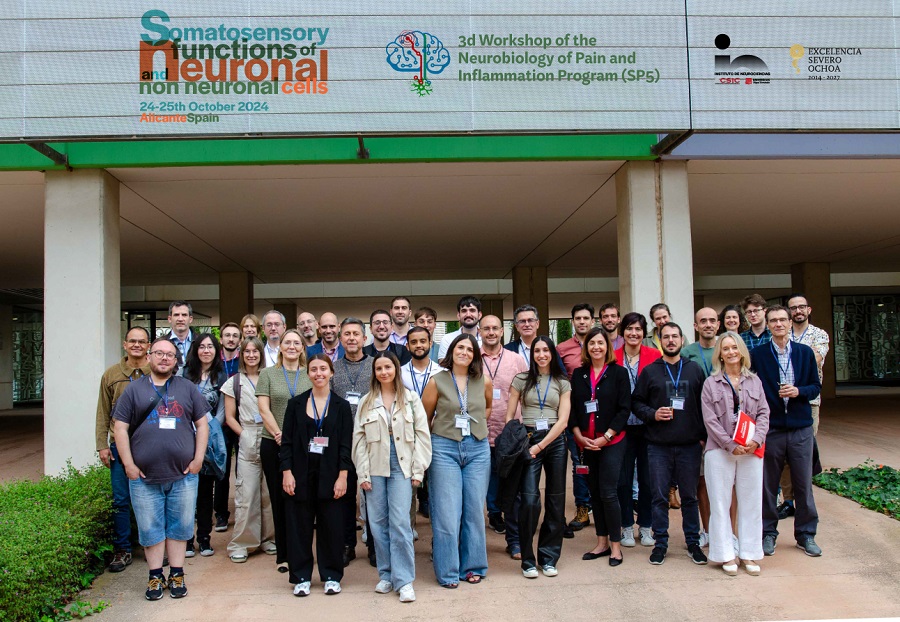Over thirty experts gather in Alicante for the III Workshop of the Neurobiology of Pain and Inflammation Scientific Program
25 de October de 2024
The Neurobiology of Pain and Inflammation scientific program at the Institute for Neurosciences (IN), a joint center of the Spanish National Research Council (CSIC) and Miguel Hernández University (UMH) of Elche, held the workshop “Somatosensory Functions of Neuronal and Non-Neuronal Cells” on Friday, October 25. This workshop, held for the third consecutive year in Alicante, brought together local and national speakers as well as internationally recognized leaders in pain and neuroinflammation research.
The event featured over thirty experts sharing recent breakthroughs in the study of cellular and molecular mechanisms involved in somatosensory processing, with a particular focus on neuron interactions with other tissues, such as skin, the immune system, glial cells, and even tumor cells.
The first session opened with Javier Aguilera Lizarraga, a researcher from the University of Cambridge (UK), who discussed the link between immune responses and abdominal pain in irritable bowel syndrome. Next, researchers from the Department of Pharmacology at the University of Granada, Rafael González Cano and Enrique Cobos, presented their studies on the use of artificial intelligence in pain assessment and pharmacological responses in animal models, respectively. Ana Gomis, from IN-CSIC-UMH, explored the role of Piezo2 channels in acute and neuropathic pain, while Sergio Sarrio, also from IN-CSIC-UMH, explained how specific parts of PIEZO1 and PIEZO2 proteins, known as “Blade domains,” play different roles in cellular localization and function.
The plenary lecture was delivered by professor Alexander Chesler from the National Center for Complementary and Integrative Health in the United States (NIH/NCCIH), focusing on the molecules and cells responsible for touch and pain.
The second session began with a talk by Romina Nassini, a researcher from the University of Florence (Italy), as part of the “Prometeo Program,” highlighting the critical role of membrane receptors in cancer-related pain. She was followed by Francesco De Logu, also from the University of Florence, who presented findings on how the C5aR1 receptor in Schwann cells activates the NLRP1 inflammasome to sustain pain in a mouse model of endometriosis. The “Grünenthal Lecture” was presented by Miguel Ángel Serrano from IN-CSIC-UMH, who discussed the role of nociceptive Schwann cells in oxaliplatin-induced peripheral neuropathy. Berta Sánchez Laorden, also from IN-CSIC-UMH, then explained how Schwann cells influence melanoma progression. To close the session, Andrés Fuentes from IN-CSIC-UMH delved into the unconventional glia-neuron interactions in sensory transmission, offering an innovative perspective on the complex cellular relationships in pain and disease.
The final session began with a presentation by Kim Chisholm from the University of Nottingham (UK), who discussed the use of in vivo microscopy to advance our understanding of chronic pain and somatosensation. David Cabañero, researcher at the Institute for Research, Development, and Innovation in Healthcare Biotechnology in Elche (IDiBE), presented on the therapeutic potential of TRPM8 ligands in a murine model of chronic migraine. Finally, Jorge de Andrés, also from IDiBE, concluded the session with his findings on modulators of PLC-beta 3 and 4 proteins, emphasizing their importance in somatosensation. This last set of presentations provided an innovative look at chronic pain research and sensory mechanisms.
The event’s organizing committee was composed of IN-CSIC-UMH researchers Félix Viana de la Iglesia, who leads the Neurobiology of Pain and Inflammation scientific program; Ana Gomis, co-leader of the Sensory Transduction and Nociception laboratory; and Hugo Cabedo, who leads the Molecular Control of Neuronal Axon Myelination laboratory.
The organization of this workshop was made possible with support from the Instituto de Neurociencias UMH-CSIC, the pharmaceutical company Grünenthal, the ‘TRILOGY’ project of the Prometeo Program from the Generalitat Valenciana, the Spanish Research Agency - Ministry of Science, Innovation, and Universities, the Spanish Ion Channel Network (RECI), and the companies QUIMA (Química y Medio Ambiente S.L.), Leica, and HB Multi Channel Systems.

Source: Institute for Neurosciences CSIC-UMH (in.comunicacion@umh.es)

 Español
Español